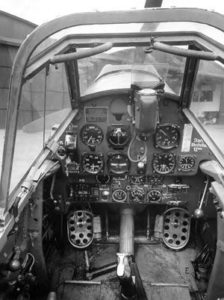From Tales of the Rampant Coyote
 One of the things I discovered flying a World War II warbird in Virtual Reality is just how small those cockpits really were. This is true of many modern fighters as well. After years of seeing the front panel stretched out from screen edge to screen edge. Sure, I used to live near Washington DC and I’d visit the National Air & Space museum as often as I could. But I was smaller (and skinnier) then, and you couldn’t usually go into the cockpits. Dropping down into the VR versions and re-discovering just how cramped the pilot’s “office” was is an eye-opener. I understand what the fighter pilots mean when they say they are “strapping on the plane.”
One of the things I discovered flying a World War II warbird in Virtual Reality is just how small those cockpits really were. This is true of many modern fighters as well. After years of seeing the front panel stretched out from screen edge to screen edge. Sure, I used to live near Washington DC and I’d visit the National Air & Space museum as often as I could. But I was smaller (and skinnier) then, and you couldn’t usually go into the cockpits. Dropping down into the VR versions and re-discovering just how cramped the pilot’s “office” was is an eye-opener. I understand what the fighter pilots mean when they say they are “strapping on the plane.”
This feels especially true when you are searching for the bandit you just lost sight of (hint: if you don’t know where he went, check your six). While there’s a great deal of freedom to move your head around that you don’t get in the normal computer flight sim experience, if you don’t want to “cheat” and stick your head through the glass, there’s not a lot of room. The top of the canopy, where I am often looking in the middle of turning or scissoring with my opponent, doesn’t seem that far from the tip of my nose. It makes sense, and it’s cool… it’s just kind of fascinating.
Modern general aviation aircraft feel rather spacious by comparison. It probably doesn’t hurt that most of them have a copilot seat to the side.
VR definitely presents scale better than traditional rendering. Everything feels like it has to be rendered larger to scale right in a traditional first-person perspective game (and, of course, your running speed is scaled accordingly, and then quadrupled). But in VR, scale is exactly right.
Another thing I’ve noted: I can play a civilian flight sim like X-Plane for an hour with no significant ill effects in VR, even though it can’t hit 90 FPS on my system. Cruising around in an aircraft in VR is not an issue. Serious sustained dogfights in a flight sim in VR will hit the limit of my endurance within 10 minutes or so. In all likelihood, I’d be blowing chunks in a real aircraft with that kind of maneuvering, so we’ll call it “realism.” When I’m in a faster plane against a more maneuverable opponent, the engagements can last a while, and there are times in VR when I give up and head for home (or just quit the game and take off the headset). I remember pushing it too far looong ago playing Descent when it first came out, how terrible I felt the rest of the day, and how I was still feeling slightly queasy the next morning. So yeah, I don’t feel inclined to try and push my tolerance too far anymore.
By far, the coolest thing about VR flight sims is that it captures the sense of flying better than anything short of a million-dollar commercial flight simulator. Or, obviously, a real aircraft. Over the weekend, I let a friend (who is also a private pilot) try out X-Plane in VR. He flew the Cessna 172, an aircraft he is quite familiar with in real life. Aside from being disoriented by trying to physically reach out and touch controls, he was blown away by how much it felt like the real thing. He said, “I feel I have a purchase coming up in the near future. How much is the game?”
I said, “The game is only about $60. But the VR gear can be $500 or more, and you need a decent computer to run it.”
He laughed and said, “Five hundred bucks? That’s almost as much as a couple of hours of plane rental and gas these days.”
Okay, yeah. Cheaper in the long run.  I’d still prefer a flight in the real thing when I can swing it. But it’s not like there’s any way I’d ever get to fly in an actual F-15 or battle over the skies of France in a Sopwith Camel in the real world. So I’ll take the virtual skies.
I’d still prefer a flight in the real thing when I can swing it. But it’s not like there’s any way I’d ever get to fly in an actual F-15 or battle over the skies of France in a Sopwith Camel in the real world. So I’ll take the virtual skies.
Original URL: http://rampantgames.com/blog/?p=12119
